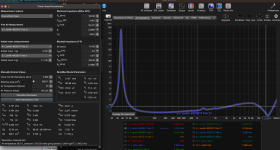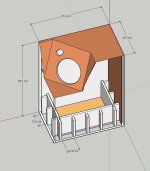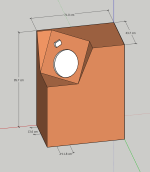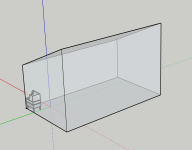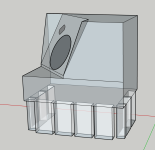Thanks much to those of you who have answered some very basic questions I have so far. I have settled on a design for my particular driver and desired usage, and would like some feeback.
The principle driver in question is a Zenith 49CZ817.
I went down two separate trains of thought here, and ended up not going open baffle...mainly because I didn't want to have the speaker that far from the wall. And, I liked the thought of not needing a dedicated amplifier/dsp system.
I spent some time trying to copy and tweak the decca corner horn to match the size and t/s parameters of my driver, and it didn't really seem to work well. Backloaded horns tended to get too large (and definitely outside my skill set), so I compared MLTLs to the simple bass reflex. Back and forth, may times. And somehow I ended up staring lovingly at the onken style.
Well... that is not what I ended up with, since I really liked the concept of backward reflecting, along with a nice plant stand. But I definitely stole something from the onken and something from the decca...and probably a lot of other places too. I still have a few questions, before I fine tune and get all the numbers matching.
Attached is the design of the speaker, along with the T/S of the driver and a hornresp file which is close (not accurate to model), but shows the modeling strategy. A big box, with a big downfiring port...Not quite Onken big, based off what I read.
1). The ports fire down, and I can adjust height from the floor...but am unclear as to how to model this in hornresp. Is there a rule of thumb minimum here?
2). The angle of the speaker is 60 from horinzontal. It will be firing upward and backward into a corner that is 8.5' in height, and slopes up to about 17'. 60 degrees was pulled for aesthetic and math purposes. Is there a better angle to consider?
3). bracing. I have not yet added the bracing to the model, and know there will very likely need to be some. I have seen a lot of braces with the circular cutout approach. Is there some minimum hole size relative to being able to ignore, or else how do I model it. Or, do I do minimal bracing and accept that the Ql will be quite high? Looking at the rough modeling, this seems to be pretty insensitive to Ql. Though i have no idea what a Ql of 50 looks like.
4). Design - Am I missing something critical in a "never do that" sense?
5). Tweeter. As of now, I know I need something to get above 6-8K, and I have a kilpsch K-89-KV, which was ripped from a center speaker. I was going to throw that in the same baffle, and figure out the crossover once in. I know nothing about this, other than I have one. Any thought on how to present tis tweeter in its best light?
The back and forth between sketchup and hornresp is fairly intensive for me, so before going further down this hole....
Thanks for thoughts and opinions.
-jeff
The principle driver in question is a Zenith 49CZ817.
I went down two separate trains of thought here, and ended up not going open baffle...mainly because I didn't want to have the speaker that far from the wall. And, I liked the thought of not needing a dedicated amplifier/dsp system.
I spent some time trying to copy and tweak the decca corner horn to match the size and t/s parameters of my driver, and it didn't really seem to work well. Backloaded horns tended to get too large (and definitely outside my skill set), so I compared MLTLs to the simple bass reflex. Back and forth, may times. And somehow I ended up staring lovingly at the onken style.
Well... that is not what I ended up with, since I really liked the concept of backward reflecting, along with a nice plant stand. But I definitely stole something from the onken and something from the decca...and probably a lot of other places too. I still have a few questions, before I fine tune and get all the numbers matching.
Attached is the design of the speaker, along with the T/S of the driver and a hornresp file which is close (not accurate to model), but shows the modeling strategy. A big box, with a big downfiring port...Not quite Onken big, based off what I read.
1). The ports fire down, and I can adjust height from the floor...but am unclear as to how to model this in hornresp. Is there a rule of thumb minimum here?
2). The angle of the speaker is 60 from horinzontal. It will be firing upward and backward into a corner that is 8.5' in height, and slopes up to about 17'. 60 degrees was pulled for aesthetic and math purposes. Is there a better angle to consider?
3). bracing. I have not yet added the bracing to the model, and know there will very likely need to be some. I have seen a lot of braces with the circular cutout approach. Is there some minimum hole size relative to being able to ignore, or else how do I model it. Or, do I do minimal bracing and accept that the Ql will be quite high? Looking at the rough modeling, this seems to be pretty insensitive to Ql. Though i have no idea what a Ql of 50 looks like.
4). Design - Am I missing something critical in a "never do that" sense?
5). Tweeter. As of now, I know I need something to get above 6-8K, and I have a kilpsch K-89-KV, which was ripped from a center speaker. I was going to throw that in the same baffle, and figure out the crossover once in. I know nothing about this, other than I have one. Any thought on how to present tis tweeter in its best light?
The back and forth between sketchup and hornresp is fairly intensive for me, so before going further down this hole....
Thanks for thoughts and opinions.
-jeff
Attachments
5). Tweeter. As of now, I know I need something to get above 6-8K, and I have a kilpsch K-89-KV, which was ripped from a center speaker. I was going to throw that in the same baffle, and figure out the crossover once in. I know nothing about this, other than I have one. Any thought on how to present tis tweeter in its best light?
Listening near-field to my 49CZ852 right now... propped up nude aimed at my ears forming equilateral triangle (realizing the most acute hearing), only the 2-5khz "romantically bright" hump needed a bit of taming. Extension both ways really quite good. Firing into room upper corners would scramble mid-to-high frequencies to (possibly) not reach the listener together. I think you might need to design and test a slightly convex corner reflector to bounce the driver(s), in order to disperse and control HF.
Listening now after a quick tone sweep by ear. 49CZ852 placed atop 25L steel can. Bass extension not bad (still loosening up), should do 40s vented or fine as is, 50s small sealed cab. Fairly obvious hump 2-5khz needs taming along with BSC. Then maybe very high frequency would show a bit better. Let run awhile.
Just curious .... from a construction standpoint, why not just extend the speaker baffle outward to bisect the two sides, as opposed to the creating the two 'wings'?
Hi @wchang. Interesting that your 852s had a hump, whereas my 817 apparently has a dip. But it was harvested from a three-way, so likely different. (https://www.diyaudio.com/community/attachments/screenshot-2025-03-10-at-11-59-03-am-png.1433422/). GM suggested that this is due to the felt dustcap.
I am curious, wchang, if you see funky phase behavior in your hump range. I see things get all wonky in the 2.5K range. Which is why I am still unsure as to the crossover point. (https://www.diyaudio.com/community/threads/how-to-model-this-speaker-is-sd-relevant.424787/)
I did spend a bit of time looking into the OB approach, since several folks really like it. But in my case, I am specifically looking for a mono solution, and so some of the benefits of OB are likely lost. Especially if I cram it in the corner, where its future home is.
I looked into the wonderful corner horn options, and this particular driver seemed to want things BIG. Much bigger than I felt would sneak into our bedroom. So the decca approach seemed a good starting point, as it has received some favorable feedback. I do like your thinking about a corner reflector...something like the lowther voight? Unfortunately, this exceed my skills at present, and I was thinking room interaction would pretty much jumble things anyway. The Decca never went as high as I intend to go, however. And so at higher frequencies this approach may not work. In which case I might very well need a separate tweeter approach. Aesthetically, I would prefer a wood waveguide - and so I would definitely need to know the frequency range first. I could certainly swap baffles and mount this external. For me, this is as much about learning, so I am game for anything within reason, but I am trying to use the drivers available to me. See where that takes me. If I am happy with it, then I get to dive a little deeper, and start a design where I give my self more latitude.
Hi @Prarieboy. Yes - that is a purely aesthetic decision. I wanted the front (as you look at it) to be unobstructed. The cuts for that do get a bit complicated. Initially, I was liking the idea of strip building this section (like boat hull), but I didn't know what shape to go for. I had never really thought of this as anything more than a one-off. Without going too far down the rabbit hole, my intent it to have this match some existing furniture, which is an eclictic cross between shaker and asian. So the construction would allow for the top half to be exchangeable during the building phase. This would also make the bracing part easier. I like the idea of being able to tweak (beyond aesthetics), and this would approach would not have occurred to me with your question!
I am curious, wchang, if you see funky phase behavior in your hump range. I see things get all wonky in the 2.5K range. Which is why I am still unsure as to the crossover point. (https://www.diyaudio.com/community/threads/how-to-model-this-speaker-is-sd-relevant.424787/)
I did spend a bit of time looking into the OB approach, since several folks really like it. But in my case, I am specifically looking for a mono solution, and so some of the benefits of OB are likely lost. Especially if I cram it in the corner, where its future home is.
I looked into the wonderful corner horn options, and this particular driver seemed to want things BIG. Much bigger than I felt would sneak into our bedroom. So the decca approach seemed a good starting point, as it has received some favorable feedback. I do like your thinking about a corner reflector...something like the lowther voight? Unfortunately, this exceed my skills at present, and I was thinking room interaction would pretty much jumble things anyway. The Decca never went as high as I intend to go, however. And so at higher frequencies this approach may not work. In which case I might very well need a separate tweeter approach. Aesthetically, I would prefer a wood waveguide - and so I would definitely need to know the frequency range first. I could certainly swap baffles and mount this external. For me, this is as much about learning, so I am game for anything within reason, but I am trying to use the drivers available to me. See where that takes me. If I am happy with it, then I get to dive a little deeper, and start a design where I give my self more latitude.
Hi @Prarieboy. Yes - that is a purely aesthetic decision. I wanted the front (as you look at it) to be unobstructed. The cuts for that do get a bit complicated. Initially, I was liking the idea of strip building this section (like boat hull), but I didn't know what shape to go for. I had never really thought of this as anything more than a one-off. Without going too far down the rabbit hole, my intent it to have this match some existing furniture, which is an eclictic cross between shaker and asian. So the construction would allow for the top half to be exchangeable during the building phase. This would also make the bracing part easier. I like the idea of being able to tweak (beyond aesthetics), and this would approach would not have occurred to me with your question!
I'm intrigued by your term of 'an eclectic mix of Shaker and Asian'. I appreciate both so like the juxtaposition of those styles.
Perhaps next weekend I'll measure phase "my way", LX over a reference flat-phase driver in opposite polarity and check if on-axis null offset shifted with frequency. Last evening I notched the hump (reported in Fullrange forum) and would like to compare phase before-and-after. But the work-week has already started here.I am curious, wchang, if you see funky phase behavior in your hump range. I see things get all wonky in the 2.5K range.
I would suggest you give omni up-firing 1yd from room corner a quick listen, driver placed over a loosely stuffed tin-can/waste-basket/washbasin. Normally, a coherent fullrange driver forms a nice floating image midair. Adding a tweeter may destroy it, but then you would know.
Last edited:
Assuming you're referring to the woofer, then this is where the ribbed part starts. BTW, what's its Fs?I am curious, wchang, if you see funky phase behavior in your hump range. I see things get all wonky in the 2.5K range. Which is why I am still unsure as to the crossover point.
Hi @wchang - as this is for my bedroom, I can't see the floor space being available. It's gotta be packed against a wall. I do like the concept, though I don't know about cone sag? but that is for a later day.
Hi @GM - First, this is the same woofer from the previous thread on "is sd relevant?". I decided not to mess with the 7", so as to start building something. I found hornresp a dangerous rabbit hole, but perhaps better than social media ;-). The Fs is 56.9, and this is tuned away lower. But hornresp seemed to suggest it was OK, though I don't quite know how to interpret the electrical impedance graph. The txt file above hase the hornresp file for what is close to being the final-ish design.
However...last night I dug a little deeper into akabak (watched some videos...). And, since I do know exactly where this is going, and in what room, it seemed highly appropriate. The room is 22 x 8.5 ft, with a ceiling slope from 8.5 to 14.5 ft. So I just spent more hours than I care to admit generating what I hope to be to correct 3d models. I am really curious to see what this will show me. And very interested in suggestions/comments.
No bracing in cabinet yet. I think the model is right? The ports don't look it, but they are open at the bottom.
Hi @GM - First, this is the same woofer from the previous thread on "is sd relevant?". I decided not to mess with the 7", so as to start building something. I found hornresp a dangerous rabbit hole, but perhaps better than social media ;-). The Fs is 56.9, and this is tuned away lower. But hornresp seemed to suggest it was OK, though I don't quite know how to interpret the electrical impedance graph. The txt file above hase the hornresp file for what is close to being the final-ish design.
However...last night I dug a little deeper into akabak (watched some videos...). And, since I do know exactly where this is going, and in what room, it seemed highly appropriate. The room is 22 x 8.5 ft, with a ceiling slope from 8.5 to 14.5 ft. So I just spent more hours than I care to admit generating what I hope to be to correct 3d models. I am really curious to see what this will show me. And very interested in suggestions/comments.
No bracing in cabinet yet. I think the model is right? The ports don't look it, but they are open at the bottom.
Attachments
Greets!
Ah! OK, for future reference, please put the HR .txt file in the EXPORT folder; re the sim, there's going to be some series resistance, typically a 1/2 ohm for wiring, so normally insignificant, but if tube or Class A, A/B it can be high enough to significantly alter the response and as is, it's realistically limited to ~2 W/40 Hz with old console drivers IME.
Never bothered to learn akabak or other steep learning curve programs, but will be much more accurate than HR for multiple vents, so curious what you wind up with.
Ah! OK, for future reference, please put the HR .txt file in the EXPORT folder; re the sim, there's going to be some series resistance, typically a 1/2 ohm for wiring, so normally insignificant, but if tube or Class A, A/B it can be high enough to significantly alter the response and as is, it's realistically limited to ~2 W/40 Hz with old console drivers IME.
Never bothered to learn akabak or other steep learning curve programs, but will be much more accurate than HR for multiple vents, so curious what you wind up with.
Steep learning curve? Understatement for me. Somewhere, somehow I can't figure out how to get my sketchup to the right mesh format. I feel like I could have built a rough shell with the amount of time I have spent circling the sketchup drain....argh. I end up having to use some online step file repair tool, which then generates a bunch of elements. Then an accidental click with gmsh, and back to square zero. There has to be something that I am missing, and I will be embarrassed once I figure it out.
But i am committed to learning this, and so curious as top what it tells me about speaker placement. And I love that these tools are open source, and group supported. A bunch of unsung heroes have certainly created a wonderful playground.
But i am committed to learning this, and so curious as top what it tells me about speaker placement. And I love that these tools are open source, and group supported. A bunch of unsung heroes have certainly created a wonderful playground.
- Home
- Loudspeakers
- Multi-Way
- Building the Zenith a home
